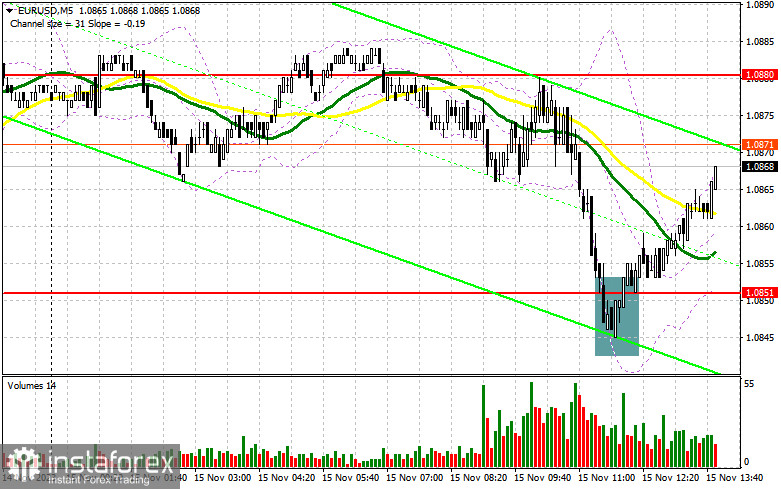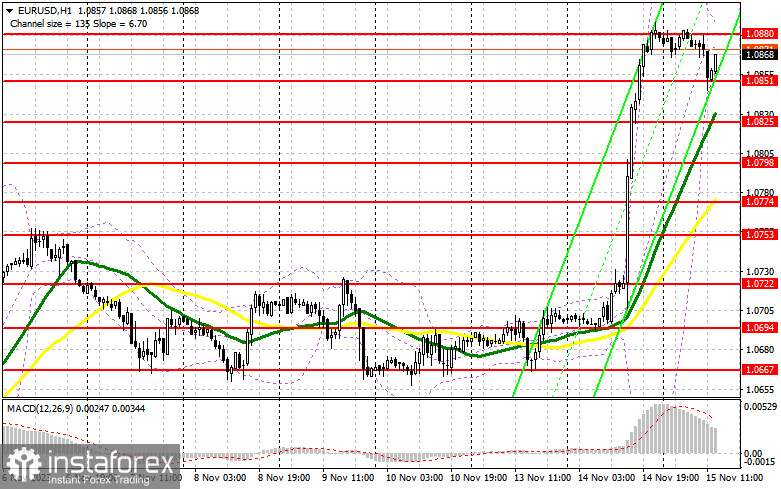In my morning forecast, I drew attention to the level of 1.0851 and recommended making decisions on market entry based on it. Let's look at the 5-minute chart and analyze what happened there. The decline and the formation of a false breakout at 1.0851 allowed for a good entry point for continuing the bullish market. The pair had already increased by about 20 points when writing this article, but the main movement is expected during the American session. The technical picture for the second half of the day still needs to be revised.

To open long positions on EUR/USD, the following is required:
The weak data on industrial production in the Eurozone during the European session helped the euro demonstrate a downward correction, but the main movement is expected after the release of US data. Ahead of us, there are changes in retail trade volume and the producer price index, as well as speeches by FOMC members Michael S. Barr and Thomas Barkin. If yesterday's scenario repeats, where inflation slowed more than expected, demand for the euro will return. However, the much more important factor is the reduction in retail sales in the US, which will lead to an immediate surge in the pair towards new monthly highs. With strong statistics, bulls must defend 1.0851 again, so I will act according to the morning forecast. The formation of a false breakout at 1.0851, similar to what I analyzed above, will provide a good entry point for long positions, expecting further development of the bullish trend and a test of resistance at 1.0880, formed by the end of yesterday. Breaking and updating this range from top to bottom will allow a surge to 1.0908. The ultimate target will be the area around 1.0938, where I will take profit. Nothing significant will happen in the scenario of a decline in EUR/USD and no activity at 1.0851 in the second half of the day. You can always re-enter the market around 1.0825. Forming a false breakout there will create a good signal for entering long positions. I will consider opening long positions immediately on the rebound from 1.0798 with a target of an upward correction within the day by 30-35 points.
To open short positions on EUR/USD, the following is required:
Sellers showed themselves in the first half of the day, but expecting more from them after yesterday's pair's rise was simply unreasonable. Weak US data will lead to a test of 1.0880, so attention should be focused on this level. The formation of a false breakout there will signal a sale, expecting another small downward correction to support at 1.0851, where major buyers have already shown themselves once today. But only after breaking and consolidating below this range, as well as a bottom-up retest, I expect to get another sell signal with an exit to 1.0825. The ultimate target will be the minimum of 1.0798, where I will take profit. There are also moving averages playing in favor of buyers. In the case of an upward movement of EUR/USD during the American session and the absence of bears at 1.0880, and most likely that will be the case, it is best to postpone sales until 1.0908. It can be sold there, but only after an unsuccessful consolidation. I will consider opening short positions immediately on the rebound from 1.0938 with a target of a downward correction by 30-35 points.


Indicator Signals:
Moving Averages
Trading is conducted above the 30 and 50-day moving averages, indicating the euro's rise.
Note: The author considers the period and prices of moving averages on the hourly chart H1 and differs from the general definition of classical daily moving averages on the daily chart D1.
Bollinger Bands
In case of a decrease, the lower boundary of the indicator will act as support around 1.0851.
Indicator Descriptions:
- Moving Average (determines the current trend by smoothing volatility and noise). Period 50. Marked on the chart in yellow.
- Moving Average (determines the current trend by smoothing volatility and noise). Period 30. Marked on the chart in green.
- MACD (Moving Average Convergence/Divergence) indicator. Fast EMA period 12. Slow EMA period 26. SMA period 9.
- Bollinger Bands. Period 20.
- Non-commercial traders - speculators, such as individual traders, hedge funds, and large institutions using the futures market for speculative purposes and meeting certain requirements.
- Long non-commercial positions represent the total long open position of non-commercial traders.
- Short non-commercial positions represent the total short open positions of non-commercial traders.
- The total non-commercial net position is the difference between non-commercial traders' short and long positions.
 English
English 
 Русский
Русский Bahasa Indonesia
Bahasa Indonesia Bahasa Malay
Bahasa Malay ไทย
ไทย Español
Español Deutsch
Deutsch Български
Български Français
Français Tiếng Việt
Tiếng Việt 中文
中文 বাংলা
বাংলা हिन्दी
हिन्दी Čeština
Čeština Українська
Українська Română
Română

